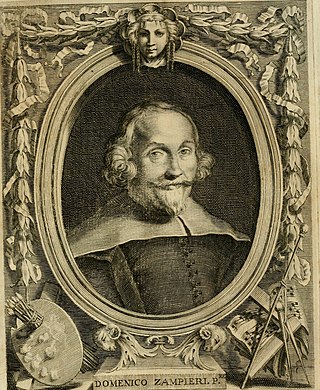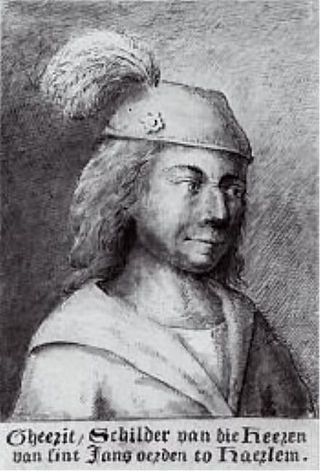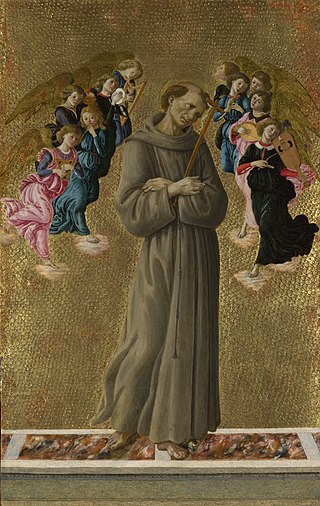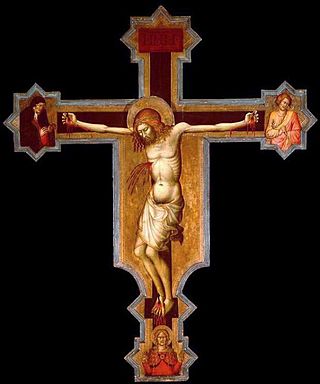Related Research Articles

Antonio Allegri da Correggio, usually known as just Correggio was an Italian Renaissance painter who was the foremost painter of the Parma school of the High Renaissance, who was responsible for some of the most vigorous and sensuous works of the sixteenth century. In his use of dynamic composition, illusionistic perspective and dramatic foreshortening, Correggio prefigured the Baroque art of the seventeenth century and the Rococo art of the eighteenth century. He is considered a master of chiaroscuro.

Lorenzo Lotto was an Italian Renaissance painter, draughtsman, and illustrator, traditionally placed in the Venetian school, though much of his career was spent in other north Italian cities. He painted mainly altarpieces, religious subjects and portraits. He was active during the High Renaissance and the first half of the Mannerist period, but his work maintained a generally similar High Renaissance style throughout his career, although his nervous and eccentric posings and distortions represented a transitional stage to the Florentine and Roman Mannerists.

BartolomeoMontagna was an Italian Renaissance painter who mainly worked in Vicenza. He also produced works in Venice, Verona, and Padua. He is most famous for his many Madonnas and his works are known for their soft figures and depiction of eccentric marble architecture. He is considered to be heavily influenced by Giovanni Bellini, in whose workshop he might have worked around 1470. Benedetto Montagna, a productive engraver, was his son and pupil and active until about 1540. He was mentioned in Vasari's Lives as a student of Andrea Mantegna but this is widely contested by art historians.

Filippo Lippi, also known as Lippo Lippi, was an Italian Renaissance painter of the Quattrocento and a Carmelite priest. He was an early Renaissance master of a painting workshop, who taught many painters. Sandro Botticelli and Francesco di Pesello were among his most distinguished pupils. His son, Filippino Lippi, also studied under him and assisted in some late works.

Domenico Zampieri, known by the diminutive Domenichino after his shortness, was an Italian Baroque painter of the Bolognese School of painters.

Alessandro Bonvicino, more commonly known as Moretto, or in Italian Il Moretto da Brescia, was an Italian Renaissance painter from Brescia, where he also mostly worked. His dated works span the period from 1524 to 1554, but he was already described as a master in 1516. He was mainly a painter of altarpieces that tend towards sedateness, mostly for churches in and around Brescia, but also in Bergamo, Milan, Verona, and Asola; many remain in the churches they were painted for. The majority of these are on canvas, but a considerable number, including some large pieces, are created on wood panels. There are only a few surviving drawings from the artist.

Geertgen tot Sint Jans, also known as Geertgen van Haarlem, Gerrit van Haarlem, Gerrit Gerritsz, Gheertgen, Geerrit, Gheerrit, or any other diminutive form of Gerald, was an Early Netherlandish painter from the northern Low Countries in the Holy Roman Empire. No contemporary documentation of his life has been traced, and the earliest published account of his life and work is from 1604, in Karel van Mander's Schilder-boeck.

Francesco Francia, whose real name was Francesco Raibolini was an Italian painter, goldsmith, and medallist from Bologna, who was also director of the city mint.

Giovanni Battista Cima, also called Cima da Conegliano, was an Italian Renaissance painter, who mostly worked in Venice. He can be considered part of the Venetian school, though he was also influenced by Antonello da Messina, in the emphasis he gives to landscape backgrounds and the tranquil atmosphere of his works.

The Galleria Nazionale d'Arte Antica or National Gallery of Ancient Art is an art museum in Rome, Italy. It is the principal national collection of older paintings in Rome – mostly from before 1800; it does not hold any antiquities. It has two sites: the Palazzo Barberini and the Palazzo Corsini.

Joos van Cleve was a leading painter active in Antwerp from his arrival there around 1511 until his death in 1540 or 1541. Within Dutch and Flemish Renaissance painting, he combines the traditional techniques of Early Netherlandish painting with influences of more contemporary Renaissance painting styles.
The decade of the 1480s in art involved some significant events.
The decade of the 1460s in art involved some significant events.

John Graver Johnson was an American corporate lawyer and art collector. The Philadelphia law firm that he founded in 1863 continues under the name Saul Ewing. His collection of nearly 1,300 paintings forms the core of early European works at the Philadelphia Museum of Art.

The Costabili collection or Costabili Gallery was a large art collection in Ferrara in the 19th century, mainly consisting of Ferrarese art. Works from the collection were purchased by mid and late 19th-century art collectors like Giovanni Morelli, Austen Henry Layard and Charles Eastlake, eventually ending in many of the major collections of art around the world. A significant group of paintings ended up in the National Gallery in London.

The Museum & Gallery, Inc. is currently located on the campus of Bob Jones University in Greenville, South Carolina. It was established in 1951, and focuses on sacred art, mainly European Old Master paintings, but also includes smaller collections of sculpture, furniture, architectural elements, textiles, Greek and Russian icons, and ancient artifacts. As of 2017, the museum is closed for a planned move to downtown Greenville, SC.

The Museo Civico di Montepulciano, also known as the Museo Civico Pinacoteca Crociani, is the town or comune art gallery and museum. It is housed in the medieval Palazzo Neri Orselli, a 14th-century structure located on Via Ricci #10, corner with Via Talosa, in the center of the town of Montepulciano, in the Province of Siena, region of Tuscany, Italy. The museum was founded in 1954.
References
- National Gallery London on the Art UK website
- Collection overview on website of the National Gallery, London
- Netherlands Institute for Art History